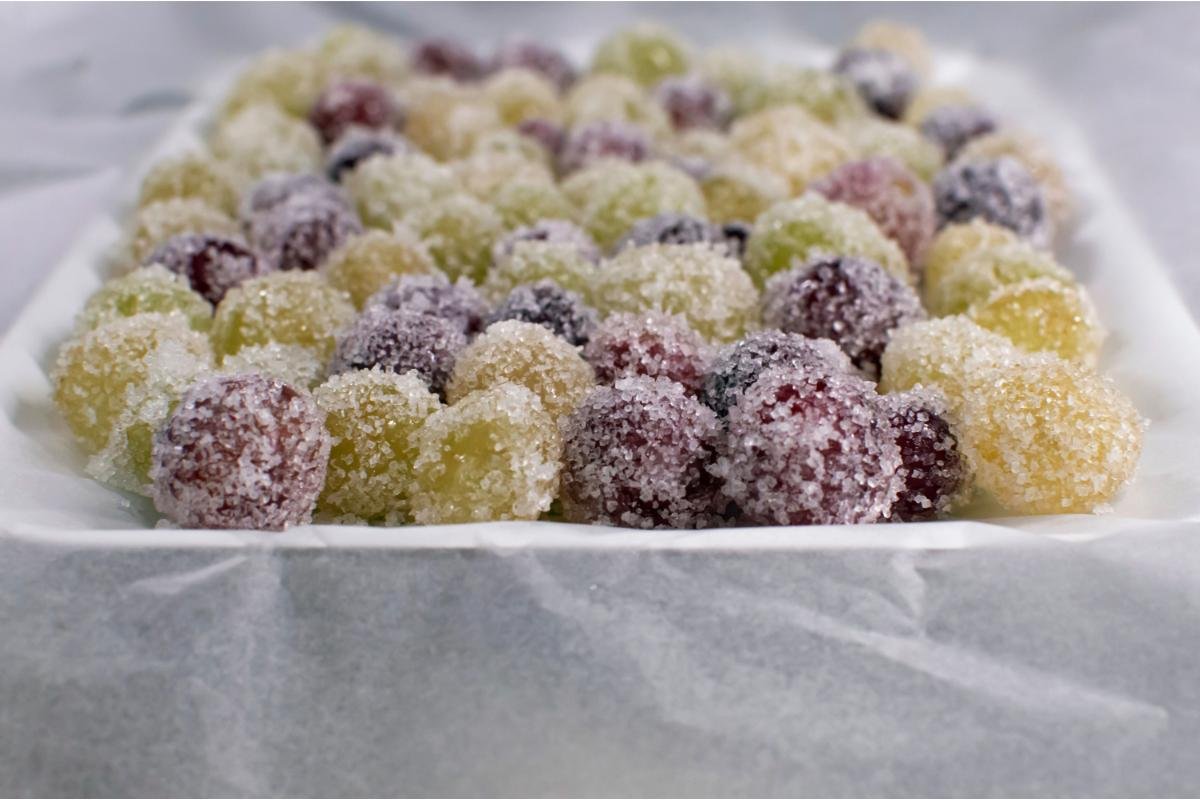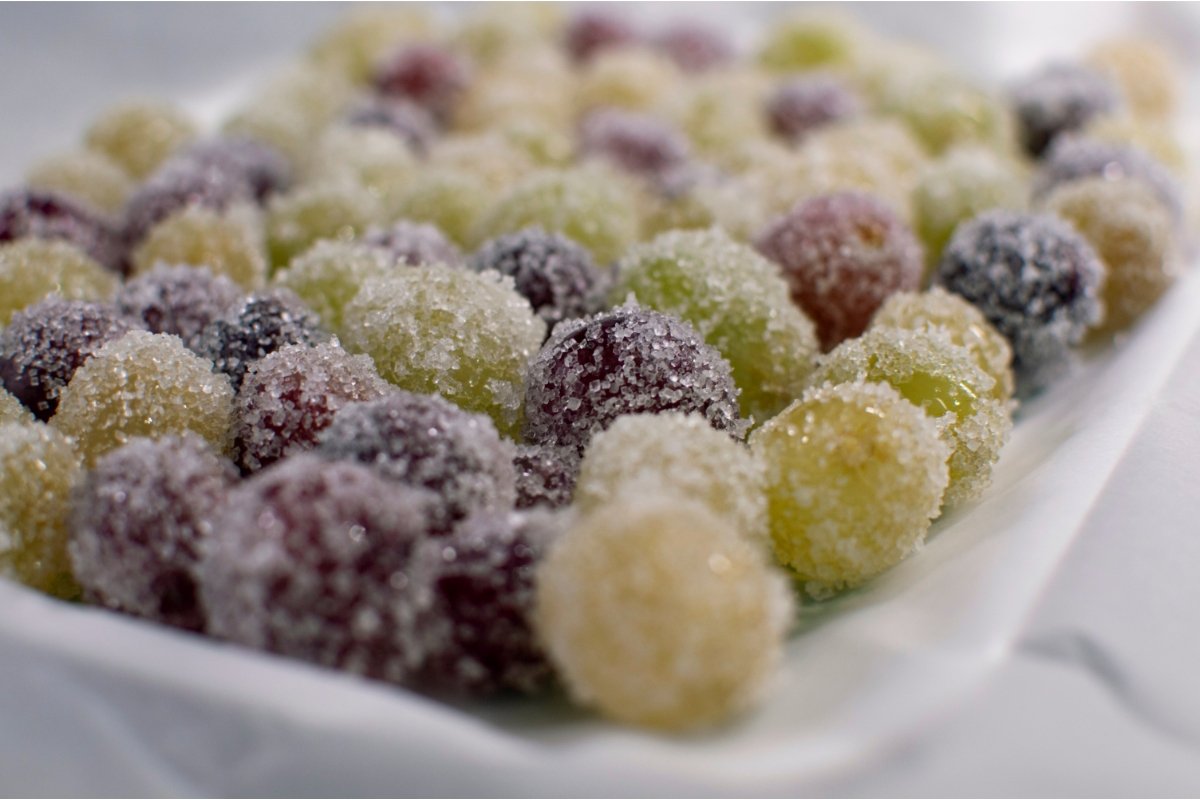The History of Candy Grapes

The journey of candy grapes from a novel idea to a popular fruit variety showcases innovation, patience, and dedication. This section explores the origins, development, and eventual market introduction of candy grapes, highlighting agricultural science’s role in creating this unique fruit.
Origins and Early Development
The quest to diversify table grape flavors beyond the traditional profiles sparked the concept of candy grapes. This endeavor aimed to enhance grapes’ appeal to a broader audience, including those who might not typically enjoy the fruit. Horticulturists and fruit breeders began this journey with extensive research and experimentation, aiming to naturally develop grape varieties with distinctly sweet, candy-like flavors.
Breakthrough in Breeding Techniques
The creation of candy grapes marked a breakthrough in breeding techniques, allowing precise selection and cross-pollination of grape varieties. Cross-breeding different grape species brought about the desired traits: sweetness, texture, size, and unique candy flavors. This process, relying on years of careful planning and selection, required patience and expertise.
Introduction to the Market
Candy grapes quickly gained popularity among consumers for their surprising and delightful flavors upon their market debut. The Cotton Candy grape, in particular, captured the public’s imagination, marking a significant moment in the fruit market. This success demonstrated the potential for traditional produce to reinvent itself in exciting ways.
Challenges and Achievements
Introducing candy grapes to the market involved overcoming challenges such as ensuring efficient growth, maintaining flavor consistency, and scaling up for commercial production. Navigating regulatory approvals, building supply chains, and convincing retailers and consumers of the grapes’ value were part of the process. Despite these obstacles, the success of candy grapes has encouraged further innovation in fruit breeding, showcasing the potential for bringing new and flavorful options to consumers.
Candy grapes’ history reflects a broader trend towards diversifying our diets with more flavorful and enjoyable options, proving that even a simple grape can undergo reinvention to bring joy and novelty to our daily lives.
How Candy Grapes are Made
The production of candy grapes is a remarkable process that combines traditional grape cultivation with cutting-edge breeding techniques. This section explores the detailed steps involved in creating these unique fruits, from initial cross-breeding to the final product that reaches consumers.
Cross-Breeding for Flavor
The journey of a candy grape begins with the meticulous cross-breeding of selected grape varieties. Breeders look for parent plants with specific desirable traits, such as natural sweetness, robust growth characteristics, and specific flavor profiles. By pollinating the flowers of one grape variety with the pollen from another, breeders can combine these traits in the offspring. This process often requires several generations of cross-breeding to stabilize the desired characteristics in the new grape variety.
Selection and Evaluation
After cross-breeding, the resulting seedlings are grown and carefully evaluated for their flavor, texture, size, and growth viability. This evaluation is critical, as it determines which plants closely match the intended outcome for candy-flavored grapes. It’s a labor-intensive phase, often involving the tasting of hundreds or even thousands of grapes to identify those with the most promising candy-like flavors. Only the best-performing plants are selected for further cultivation and development.
Cultivation and Harvesting
Selected candy grape varieties are then propagated and grown in vineyards under conditions that best suit their growth and flavor development. This stage requires precise management of sunlight, water, and soil conditions to ensure the grapes achieve their characteristic candy flavor. The timing of the harvest is also crucial, as picking the grapes at the optimal moment ensures the highest sugar content and the most pronounced candy flavor.
Quality Control and Distribution
Before reaching the market, candy grapes undergo stringent quality control to ensure they meet the expected flavor profile and quality standards. This process includes testing for sweetness levels, size uniformity, and overall appearance. Once approved, the grapes are carefully packaged and distributed to retailers, maintaining the cold chain to preserve their freshness and flavor until they reach consumers.
Challenges in Production
Producing candy grape involves overcoming several challenges, such as ensuring consistency in flavor across different growing seasons and regions. Breeders and growers must continuously adapt their techniques to account for environmental variables that could affect the grapes’ taste and quality. Additionally, the novelty of these grapes requires ongoing consumer education and marketing efforts to sustain demand.
The creation of candy grapes exemplifies the incredible potential of agricultural science to innovate within the realm of natural food production. By carefully blending traditional cultivation methods with modern breeding techniques, growers can produce grapes that offer a completely new eating experience, one that challenges our expectations of what natural fruits can taste like.
Varieties of Candy Grapes

Candy grapes come in a variety of flavors, each with its unique taste profile that resembles popular candies. This diversity not only showcases the innovation in grape breeding but also caters to a wide range of consumer preferences. Below, we explore some of the most popular varieties of candy grapes, their flavor characteristics, and their availability.
Cotton Candy Grapes
Cotton Candy grapes are perhaps the most well-known variety of candy grapes. As the name suggests, these grapes have a distinctive flavor that closely mimics the sweet, airy taste of cotton candy. The development of Cotton Candy grapes was a significant milestone in the candy grape industry, capturing the public’s imagination and setting the stage for the creation of other candy-flavored varieties. These grapes are typically available in late summer to early fall, making them a sought-after treat during that season.
Candy Hearts Grapes
Candy Hearts grapes are a newer variety that boasts a rich, sweet flavor with hints of berry and floral notes. The texture is firm and crunchy, providing a satisfying eating experience. The flavor profile of Candy Hearts grapes is complex and has been praised for its depth and balance, making it a favorite among those who appreciate nuanced tastes in their fruit. They are usually available in mid to late summer.
Gum Drops Grapes
Gum Drops grapes offer a sweet, grapey flavor with a hint of gummy candy sweetness. This variety is known for its juicy texture and vibrant purple color, making it not only delicious but visually appealing as well. Gum Drops grapes are an excellent example of how breeders can create a fruit that appeals to candy lovers while still maintaining the essence of a grape. They tend to be available in early to mid-summer.
Flavor Pop Grapes
Flavor Pop grapes are characterized by their explosive sweetness and slightly tangy aftertaste, reminiscent of certain fruity popsicles and candies. These grapes are firm and juicy, with a balance of sugar and acidity that makes them incredibly refreshing, especially on a hot day. The Flavor Pop variety demonstrates the versatility of candy grapes in mimicking a wide range of candy flavors. Availability is generally in the late summer.
Availability and Seasonal Aspects
The availability of candy grape varieties is largely dependent on their growing season, which can vary based on the climate and region they are grown in. Generally, candy grapes are available from late spring through early fall, with specific varieties peaking at different times. It’s important for consumers to be aware of the seasonal nature of these grapes to enjoy them at their best.
Candy grapes have significantly enriched the grape market, offering consumers novel taste experiences that go beyond the traditional grape flavors. As agricultural technology and breeding techniques continue to evolve, we can expect to see even more innovative and delightful varieties being developed.
Nutritional Information
Candy grapes not only offer unique and delightful flavors but also present a nutritional profile that makes them a healthy choice for snacking. This section compares the nutritional content of candy grapes to traditional grape varieties, highlighting their health benefits and any considerations to keep in mind.
Nutritional Content of Candy Grapes
Candy grapes, like their traditional counterparts, are low in calories and contain no fat, making them an excellent snack for those looking to maintain a healthy diet. They are rich in vitamins and minerals, including Vitamin C, Vitamin K, and potassium, which are essential for overall health. Additionally, candy grapes provide dietary fiber, which supports digestive health.
One of the most appealing aspects of candy grapes is their high natural sugar content, which contributes to their sweet flavor. While this makes them taste like a treat, it’s important to note that the sugars in candy grapes are natural, as opposed to the added sugars found in many candy products. This means they can offer a healthier alternative to processed snacks while still satisfying a sweet tooth.
Comparison with Traditional Grapes
When comparing the nutritional profiles of candy grapes to traditional grape varieties, the differences are minimal. Both types of grapes offer similar amounts of vitamins, minerals, and dietary fiber. The primary distinction lies in the flavor profiles and the perception of sweetness, with candy grapes often perceived as sweeter due to their unique breeding.
However, it’s worth noting that the perceived sweetness of candy grapes does not significantly impact their caloric content compared to traditional grapes. The caloric content of grapes, in general, is relatively low, making both candy and traditional grapes a nutritious option for a healthy snack.
Health Benefits
Eating candy grapes as part of a balanced diet can contribute to several health benefits, including:
- Antioxidant Properties: Grapes are known for their antioxidant content, particularly resveratrol, which is linked to heart health and protection against certain diseases.
- Hydration: With a high water content, grapes help maintain hydration, which is crucial for overall health.
- Eye Health: The Vitamin K in grapes supports bone health, while other compounds like lutein and zeaxanthin are beneficial for eye health.
Considerations
While candy grapes are a healthy snack option, moderation is key, especially for individuals monitoring their sugar intake, such as those with diabetes. The natural sugars, while healthier than processed sugars, should still be consumed in moderation as part of a balanced diet.
Candy Grapes vs. Traditional Grapes
The introduction of candy grapes into the market has sparked interest and curiosity among consumers, leading to comparisons with traditional grape varieties. This section explores the differences in taste, consumer preferences, and market trends between candy grapes and traditional grapes, shedding light on the evolving landscape of fruit consumption.
Taste Comparison
The most distinguishing feature of candy grapes is their unique flavor profile, which sets them apart from traditional grape varieties. While traditional grapes offer a range of tastes from sweet to tart, candy grapes are bred specifically to mimic the flavors of popular candies, such as cotton candy and bubblegum. This breeding process results in a fruit that provides an unexpectedly sweet and flavorful experience, contrasting with the more subtle sweetness and flavor complexity of traditional grapes.
Consumer Preferences
Consumer preferences have shown a growing interest in unique and novel food experiences, which candy grapes perfectly embody. The novelty of tasting a grape that resembles the flavor of cotton candy or another beloved sweet treat has made candy grapes particularly popular among younger demographics. However, traditional grapes continue to hold strong appeal due to their natural, classic taste and versatility in cooking and snacking. The preference often comes down to the occasion, with candy grapes being favored for their fun and novelty, while traditional grapes are appreciated for their natural taste and culinary flexibility.
Market Trends
The market for candy grapes has seen significant growth since their introduction, driven by consumer interest in innovative and flavorful fruit options. This trend is part of a larger movement towards premiumization in the produce sector, where consumers are willing to pay a premium for products that offer a unique experience or enhanced taste. Despite their higher price point compared to traditional grape varieties, candy grapes have carved out a niche in the market, indicating a strong demand for specialty produce.
However, traditional grapes continue to dominate the market in terms of volume and accessibility. Their longstanding presence and wide range of uses, from fresh consumption to wine production, ensure their continued popularity. The market dynamics between candy grapes and traditional grapes highlight a complementary relationship, with each catering to different consumer needs and occasions.
Future Prospects
As agricultural technology and breeding techniques continue to advance, the future may hold even more varieties of candy grapes and other fruit with enhanced flavors. This innovation could lead to a more diverse market where traditional and novelty varieties coexist, offering consumers a broader range of choices to suit their tastes and preferences.
Candy Grapes in Popular Culture
Candy grapes have transcended their status as a mere fruit to become a cultural phenomenon, illustrating how food innovation can capture the public’s imagination. This section delves into the impact of candy grapes on consumer trends, social media, and their representation in media, highlighting their influence beyond the produce aisle.
Social Media Sensation
Candy grapes have become a sensation on social media platforms, where their novelty and unique flavors have sparked curiosity and excitement among users. Influencers and food enthusiasts frequently share their experiences of trying candy grapes for the first time, along with creative recipes and serving suggestions. These posts often go viral, drawing attention to the fruit and contributing to its popularity. The visual appeal of candy grapes, combined with their distinctive taste, makes them an ideal subject for content creation, helping to spread awareness and increase demand.
Influencing Consumer Trends
The popularity of candy-grapes reflects broader consumer trends towards seeking out unique and experiential food products. This preference for novelty and flavor innovation has encouraged producers to explore new fruit varieties and hybrid fruits, aiming to capture the market’s interest. Candy grapes have demonstrated that there is a willing audience for fruit varieties that offer something beyond the traditional, encouraging ongoing experimentation and development in the agricultural sector.
Representation in Media
Candy grapes have also made their way into various forms of media, including television shows, magazines, and online publications, often featured in segments about food trends, healthy eating, and agricultural innovation. Their story—from the complex breeding process to their success in the market—provides a compelling narrative about the intersection of science, food, and consumer preference. These appearances have further solidified candy grapes’ position in popular culture, making them more than just a passing trend.
Impact on the Culinary World
The culinary world has taken note of candy grapes, with chefs and food companies incorporating them into menus and products. Their unique flavor profiles offer new possibilities for desserts, drinks, and even savory dishes, inspiring creativity in the kitchen. Candy grapes have shown that even small innovations in food can have a wide-reaching impact, influencing trends in culinary arts and consumer expectations.
Conclusion
Candy grapes showcase the exciting blend of innovation, flavor, and consumer curiosity. They prove how traditional agriculture can adopt creativity to meet modern tastes. From their beginning as a novel idea to becoming a cultural hit, candy grapes have proven there’s a huge demand for foods that mix the familiar with the new. Their distinct flavors challenge how we think about fruit, while their health benefits and versatility in cooking ensure they’re more than a gimmick. Looking ahead, candy grapes highlight the possibilities for ongoing innovation in our food supply, promising new flavors, experiences, and ways to enjoy nature’s offerings.
Candy grapes stand as more than a passing fad. They celebrate the agricultural community’s creativity and determination, offering a peek into the future of fruit growing and eating. As we enjoy each sweet bite, we see the boundless opportunities in food innovation.
For more on the cutting-edge world of fruit breeding and the latest on candy grape varieties, explore the International Fruit Genetics (IFG) website. Leading the charge in developing new fruit varieties, including candy grapes , IFG’s efforts continue to redefine flavor and consumer experiences in the fruit market.

